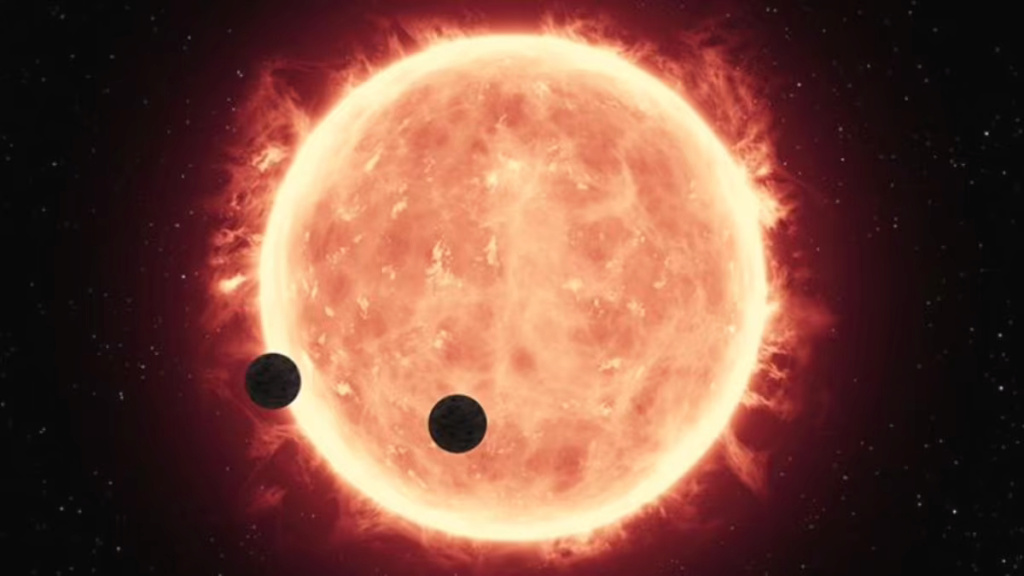The discovery of two rocky Earth-like planets, one of which may be
! habitable

Scientists have discovered, in close orbit around the faint star, two rocky exoplanets; One of them is far from the cold, faint star.
Although it is necessary to study in depth to ascertain the nature of these two planets more, this discovery is really interesting. It could mean that there are more worlds that are still unknown until now, which may be nearby in the solar neighborhood.
Even if an exoplanet is not habitable, worlds in the habitable zone are relatively rare, especially those of rocky planets; Which gives this discovery great importance.
The two exoplanets were discovered as a result of several observations made by NASA's TESS telescope dedicated to discovering exoplanets. When it was gazing at a small red dwarf star called LP 890-9 (AKA TOI-4306), the telescope detected the faint regular dips in the starlight characteristic of an exoplanet. It orbits between us and the star, passages known as transits.
And these transit data can tell us a little bit about an exoplanet. There is the fact that it exists, for example. Then there is the orbital period. Based on the amount of starlight dimming, scientists can also infer the diameter of an exoplanet. But a deeper follow-up needs to be done to make sure this discovery is correct.
For her part, astronomer Laetitia Delrez explains; from the University of Liège in Belgium that this "follow-up" is particularly important in the case of relatively cool stars, such as TOI-4306, which emit most of their light in the near-infrared and for other purposes.
She and her team used the SPECULOOS (EClipsing ULtra-cOOl Stars) telescopes, which are sensitive to the near-infrared wavelengths emitted by TOI-4306. Transit data obtained in these observations confirmed the existence of an exoplanet, named LP 890-9b.
The team then searched for exoplanets that TESS might have missed — and found a second world, slightly farther from the star than LP 890-9b. This exoplanet, named LP 890-9c, has an orbital period of 8.4 days.
Other data, including radial velocity measurements that determine the gravitational pull an exoplanet exerts on a star, allowed the team to characterize the two exoplanets in detail.
Although the two masses were not measured, the radial velocity data gave the scientists an upper limit of mass for both exoplanets.
LP 890-9b is about 1.32 times the diameter of Earth, and has a mass 13 times that of Earth. These measurements correspond to the density of rocky worlds, such as Earth, Mars and Venus, rather than gaseous or icy worlds such as Jupiter or Neptune.
This means that the exoplanets can be classified as superterrestrial planets, that is, rocky worlds larger than Earth and smaller than Neptune.
This is perhaps one of the first things that scientists look for in assessing the possibility of inhabiting an alien world; An exoplanet too close to or too far from its star would be too hot or too cold, respectively, for life as we know it.
But there is a temperate or habitable region in the vicinity of each star's orbit; Where liquid water can remain stable on the surface of the planet.
LP 890-9c may be in orbit closer to its star than Earth, but this star is much cooler and fainter than the Sun.
In its orbital position, the exoplanet lies within the habitable zone of its star, and receives stellar radiation levels similar to Earth.
In this regard, says astronomer Robert Wells; From the University of Bern in Germany: "But we shouldn't put too much hope in it; our neighbor is Venus, which is, so to speak, a CO2-rich pressure cooker, near 500°C, near this habitable zone around the Sun." .
For his part, says astronomer Amaury Triaud; From the University of Birmingham in the UK: "It is important to discover as many temperate terrestrial worlds as possible to study the diversity of exoplanet climates, which will eventually be in a position to study the universe more deeply."
LP 890-9c is very close to the point where a small planet, like Venus, might experience a greenhouse effect, but we don't know for sure what's going on there.
The James Webb Space Telescope has already proven to be an adept at discovering planets and probing the depths of space. On the other hand, a promising target like the LP 890-9c may require clamor, because whatever the outcome, we have something to learn from it.
https://www.arageek.com/news/two-rocky-super-earths-discovered?fbclid=IwAR3FsO0MqvBwOGTzFsIAjfYHVxqMeb0QW8PzSPlKBh9H9pMAujaVYnFqJ0s

